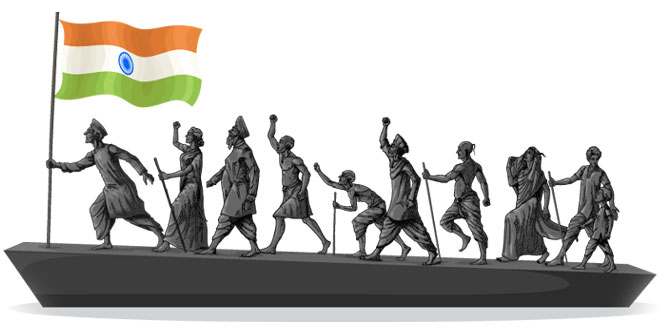Question: Why was the Civil Disobedience Movement called off by Gandhiji?
Answer:
- When Indian leaders were arrested, angry crowds demonstrated in the streets of Peshawar, facing armored cars and police firing. Many were killed.
- A month later, when Gandhiji himself was arrested, industrial workers attacked police posts, government buildings, law courts and railway stations and all structures that symbolized the British rule.
- A frightened government responded with a policy of brutal repression. Peaceful satyagrahis were attacked, women and children were beaten, and about 100,000 people were arrested.
- To break the deadline between Congress and the government Lord Irwin invited Gandhiji for a peace pact i.e Gandhi-Irwin pact.
- Under such a situation Gandhiji decided to call off the movement.
Question: Why was the Civil Disobedience Movement relaunched by Gandhiji?
Answer:
- Failure of the Second Round Table Conference: In December 1931, Gandhiji went to London for the conference, but the negotiations broke down, and he returned disappointed.
- New cycle of repression: Back in India, Gandhiji discovered that the government had begun a new cycle of repression. Khan Abdul Ghaffar Khan and Jawaharlal Nehru were both in jail, the Congress had been declared illegal, and a series of measures had been imposed to prevent meetings, demonstrations and boycotts. With great apprehension, Mahatma Gandhi relaunched the Civil Disobedience Movement.
Question: Who designed the Swaraj flag? What were the features of this flag? How was it used as a symbol of defiance?
Answer: Gandhi ji.
- It was a tricolor (red, green and white).
- It had a spinning wheel in the center.
- It had eight lotus representing eight provinces of British India, and a crescent moon, representing Hindus and Muslims.
People used to carry the flag, holding it aloft, during marches.
Question: Explain:
- Why is the growth of nationalism in the colonies linked to an anti-colonial movement?
- How did the First World War help in the growth of the National Movement in India?
Or
Explain any four facts to show how did the First World War help in the growth of the National Movement in India.
- Why were Indians outraged by the Rowlatt Act?
- Why did Gandhiji decide to withdraw the Non-Cooperation Movement?
Answer: (I)
- In India, as in Vietnam and many other colonies, the growth of modem nationalism is intimately connected to the Anti-colonial Movement. People began discovering their unity in the process of their struggle with colonialism. The sense of being oppressed under colonialism provided a shared bond that tied many different groups together.
- The European powers considered their culture more civilized, modern and superior. They forcefully started imposing their culture on the colonies. This also aroused the feeling of nationalism.
- Gandhiji used ‘Satyagraha’ against the Britishers. This also promoted the spirit of nationalism among the people.
- The anti-colonial movement was a united struggle by the people against the foreigners. The united struggle was responsible for arousing the spirit of nationalism.
(II). The War created a new economic and political situation:
- It led to a huge increase in defence expenditure which was financed by war loans and increasing taxes, customs duties were raised, and income tax introduced.
- Through the war years, prices increased – doubling between 1913 and 1918 – leading to extreme hardships for the common people.
- Villagers were called upon to supply soldiers, and the forced recruitment in rural areas caused widespread anger.
(III).
- Rowlatt Act was passed through the Imperial Legislative Council on a report of the Sedition Committee, headed by Justice Rowlatt.
- It was the black act which gave the government and the police to repress political activities, and allowed detention of political prisoners without tried for two years.
- The Act was passed despite the united opposition of the Indian members of the Council. This Act became one of the factors due to which Gandhiji launched Non-Cooperation Movement.
(Iv). In February 1922, Gandhiji decided to withdraw the Non-Cooperation Movement due to the following reasons:
- The movement was turning violent. At Chauri-Chaura in Gorakhpur, a peaceful demonstration in a bazaar turned into a violent clash in which more than 20 policemen were killed.
- Gandhiji felt that the Satyagrahis needed to be properly trained before they would be ready for mass struggle.
- Within the Congress, some leaders were tired of mass struggles and wanted to participate in elections to the provincial councils, which were set up under the Government of India Act, 1919.
- Industrialists, workers, peasants etc. interpreted the term ‘Swaraj’ in their own way. At many places like that of Andhra Pradesh, leaders like Alluri Sitaram Raju asserted that India could be liberated only by the use of force. But there values were not approved by the Congress.
Question: What is meant by the idea of Satyagraha ?
Or
Explain the idea of Satyagraha according to Gandhiji.
Answer:
- It was a non-violent method of mass agitation against the Oppressor.
- It emphasized the power of truth and the need to search the truth.
- It suggested that if the cause was true, if the struggle was against injustice, there is no need for physical force to fight the oppressor.
- People-including the oppressors had to be persuaded to see the truth instead of being forced to accept truth through the use of violence.
- By this struggle, truth was bound to be victorious.
 Class Notes NCERT Solutions for CBSE Students
Class Notes NCERT Solutions for CBSE Students





